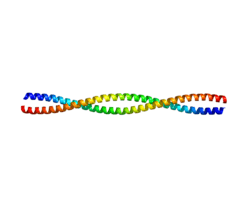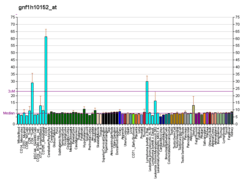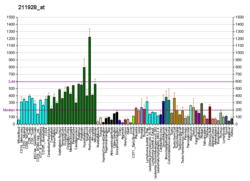DYNC1H1
Cytoplasmic dynein 1 heavy chain 1 is a protein that in humans is encoded by the DYNC1H1 gene.[5][6][7]
Clinical relevance
Mutations in this gene have been shown to cause dominant axonal Charcot-Marie-Tooth disease[10] as well as spinal muscular atrophy with lower extremity predominance (SMA-LED).[11]
gollark: > > There's also a few snippets of code on the Android version that allows for the downloading of a remote zip file, unzipping it, and executing said binary> so here's the thing, TikTok as an app, continuously downloads files i.e video files, it's kinda the whole point. there's nothing "odd" about being able to download and extract zip files, the odd thing is delivering executables via zip. however, this is a non-issue and honestly a red herring, why?This is irrelevant. Yes, downloading video files is normal, downloading extra code which might be doing whatever (subject to sandboxing, at least) is not.
gollark: It could record locally and upload later, though.
gollark: This person apparently reverse-engineered it statically, not at runtime, but it *can* probably detect if you're trying to reverse-engineer it a bit while running.
gollark: > > App behavior changes slightly if they know you're trying to figure out what they're doing> this sentence makes no sense to me, "if they know"? he's dissecting the code as per his own statement, thus looking at rows of text in various format. the app isn't running - so how can it change? does the app have self-awareness? this sounds like something out of a bad sci-fi movie from the 90's.It's totally possible for applications to detect and resist being debugged a bit.
gollark: > this is standard programming dogma, detailed logging takes a lot of space and typically you enable logging on the fly on clients to catch errors. this is literally cookie cutter "how to build apps 101", and not scary. or, phrased differently, is it scary if all of that logging was always on? obviously not as it's agreed upon and detailed in TikTok's privacy policy (really), so why is it scary that there's an on and off switch?This is them saying that remotely configurable logging is fine and normal; I don't think them being able to arbitrarily gather more data is good.
References
- GRCh38: Ensembl release 89: ENSG00000197102 - Ensembl, May 2017
- GRCm38: Ensembl release 89: ENSMUSG00000018707 - Ensembl, May 2017
- "Human PubMed Reference:". National Center for Biotechnology Information, U.S. National Library of Medicine.
- "Mouse PubMed Reference:". National Center for Biotechnology Information, U.S. National Library of Medicine.
- Pfister KK, Fisher EM, Gibbons IR, Hays TS, Holzbaur EL, McIntosh JR, Porter ME, Schroer TA, Vaughan KT, Witman GB, King SM, Vallee RB (November 2005). "Cytoplasmic dynein nomenclature". J Cell Biol. 171 (3): 411–3. doi:10.1083/jcb.200508078. PMC 2171247. PMID 16260502.
- Vaisberg EA, Grissom PM, McIntosh JR (August 1996). "Mammalian cells express three distinct dynein heavy chains that are localized to different cytoplasmic organelles". J Cell Biol. 133 (4): 831–42. doi:10.1083/jcb.133.4.831. PMC 2120833. PMID 8666668.
- "Entrez Gene: DYNC1H1 dynein, cytoplasmic 1, heavy chain 1".
- Tai, Chin-Yin; Dujardin Denis L; Faulkner Nicole E; Vallee Richard B (March 2002). "Role of dynein, dynactin, and CLIP-170 interactions in LIS1 kinetochore function". J. Cell Biol. United States. 156 (6): 959–68. doi:10.1083/jcb.200109046. ISSN 0021-9525. PMC 2173479. PMID 11889140.
- Ajuh, P; Kuster B; Panov K; Zomerdijk J C; Mann M; Lamond A I (December 2000). "Functional analysis of the human CDC5L complex and identification of its components by mass spectrometry". EMBO J. ENGLAND. 19 (23): 6569–81. doi:10.1093/emboj/19.23.6569. ISSN 0261-4189. PMC 305846. PMID 11101529.
- Weedon MN, Hastings R, Caswell R, Xie W, Paszkiewicz K, Antoniadi T, Williams M, King C, Greenhalgh L, Newbury-Ecob R, Ellard S (August 2011). "Exome sequencing identifies a DYNC1H1 mutation in a large pedigree with dominant axonal Charcot-Marie-Tooth disease". Am. J. Hum. Genet. 89 (2): 308–12. doi:10.1016/j.ajhg.2011.07.002. PMC 3155164. PMID 21820100.
- Harms MB, Ori-McKenney KM, Scoto M, Tuck EP, Bell S, Ma D, Masi S, Allred P, Al-Lozi M, Reilly MM, Miller LJ, Jani-Acsadi A, Pestronk A, Shy ME, Muntoni F, Vallee RB, Baloh RH (2012). "Mutations in the tail domain of DYNC1H1 cause dominant spinal muscular atrophy". Neurology. 78 (16): 1714–1720. doi:10.1212/WNL.0b013e3182556c05. PMC 3359582. PMID 22459677.
Further reading
- Narayan D, Desai T, Banks A, et al. (1995). "Localization of the human cytoplasmic dynein heavy chain (DNECL) to 14qter by fluorescence in situ hybridization". Genomics. 22 (3): 660–1. doi:10.1006/geno.1994.1447. PMID 8001984.
- Vaisberg EA, Koonce MP, McIntosh JR (1993). "Cytoplasmic dynein plays a role in mammalian mitotic spindle formation". J. Cell Biol. 123 (4): 849–58. doi:10.1083/jcb.123.4.849. PMC 2200153. PMID 8227145.
- Vaughan KT, Mikami A, Paschal BM, et al. (1997). "Multiple mouse chromosomal loci for dynein-based motility". Genomics. 36 (1): 29–38. doi:10.1006/geno.1996.0422. PMID 8812413.
- Bonaldo MF, Lennon G, Soares MB (1997). "Normalization and subtraction: two approaches to facilitate gene discovery". Genome Res. 6 (9): 791–806. doi:10.1101/gr.6.9.791. PMID 8889548.
- Nagase T, Ishikawa K, Nakajima D, et al. (1997). "Prediction of the coding sequences of unidentified human genes. VII. The complete sequences of 100 new cDNA clones from brain which can code for large proteins in vitro". DNA Res. 4 (2): 141–50. doi:10.1093/dnares/4.2.141. PMID 9205841.
- Neesen J, Koehler MR, Kirschner R, et al. (1997). "Identification of dynein heavy chain genes expressed in human and mouse testis: chromosomal localization of an axonemal dynein gene". Gene. 200 (1–2): 193–202. doi:10.1016/S0378-1119(97)00417-4. PMID 9373155.
- Byers HR, Yaar M, Eller MS, et al. (2000). "Role of cytoplasmic dynein in melanosome transport in human melanocytes". J. Invest. Dermatol. 114 (5): 990–7. doi:10.1046/j.1523-1747.2000.00957.x. PMID 10771482.
- Habermann A, Schroer TA, Griffiths G, Burkhardt JK (2001). "Immunolocalization of cytoplasmic dynein and dynactin subunits in cultured macrophages: enrichment on early endocytic organelles". J. Cell Sci. 114 (Pt 1): 229–240. PMID 11112706.
- Sasaki S, Shionoya A, Ishida M, et al. (2001). "A LIS1/NUDEL/cytoplasmic dynein heavy chain complex in the developing and adult nervous system". Neuron. 28 (3): 681–96. doi:10.1016/S0896-6273(00)00146-X. PMID 11163259.
- Strausberg RL, Feingold EA, Grouse LH, et al. (2003). "Generation and initial analysis of more than 15,000 full-length human and mouse cDNA sequences". Proc. Natl. Acad. Sci. U.S.A. 99 (26): 16899–903. Bibcode:2002PNAS...9916899M. doi:10.1073/pnas.242603899. PMC 139241. PMID 12477932.
- Payne C, Rawe V, Ramalho-Santos J, et al. (2004). "Preferentially localized dynein and perinuclear dynactin associate with nuclear pore complex proteins to mediate genomic union during mammalian fertilization". J. Cell Sci. 116 (Pt 23): 4727–38. doi:10.1242/jcs.00784. PMID 14600259.
- Byers HR, Maheshwary S, Amodeo DM, Dykstra SG (2003). "Role of cytoplasmic dynein in perinuclear aggregation of phagocytosed melanosomes and supranuclear melanin cap formation in human keratinocytes". J. Invest. Dermatol. 121 (4): 813–20. doi:10.1046/j.1523-1747.2003.12481.x. PMID 14632200.
- Ota T, Suzuki Y, Nishikawa T, et al. (2004). "Complete sequencing and characterization of 21,243 full-length human cDNAs". Nat. Genet. 36 (1): 40–5. doi:10.1038/ng1285. PMID 14702039.
- Navarro-Lérida I, Martínez Moreno M, Roncal F, et al. (2004). "Proteomic identification of brain proteins that interact with dynein light chain LC8". Proteomics. 4 (2): 339–46. doi:10.1002/pmic.200300528. PMID 14760703.
- Colland F, Jacq X, Trouplin V, et al. (2004). "Functional proteomics mapping of a human signaling pathway". Genome Res. 14 (7): 1324–32. doi:10.1101/gr.2334104. PMC 442148. PMID 15231748.
- Jin J, Smith FD, Stark C, et al. (2004). "Proteomic, functional, and domain-based analysis of in vivo 14-3-3 binding proteins involved in cytoskeletal regulation and cellular organization". Curr. Biol. 14 (16): 1436–50. doi:10.1016/j.cub.2004.07.051. PMID 15324660.
- Gerhard DS, Wagner L, Feingold EA, et al. (2004). "The status, quality, and expansion of the NIH full-length cDNA project: the Mammalian Gene Collection (MGC)". Genome Res. 14 (10B): 2121–7. doi:10.1101/gr.2596504. PMC 528928. PMID 15489334.
- Andersen JS, Lam YW, Leung AK, et al. (2005). "Nucleolar proteome dynamics". Nature. 433 (7021): 77–83. Bibcode:2005Natur.433...77A. doi:10.1038/nature03207. PMID 15635413.
External links
This article is issued from Wikipedia. The text is licensed under Creative Commons - Attribution - Sharealike. Additional terms may apply for the media files.






